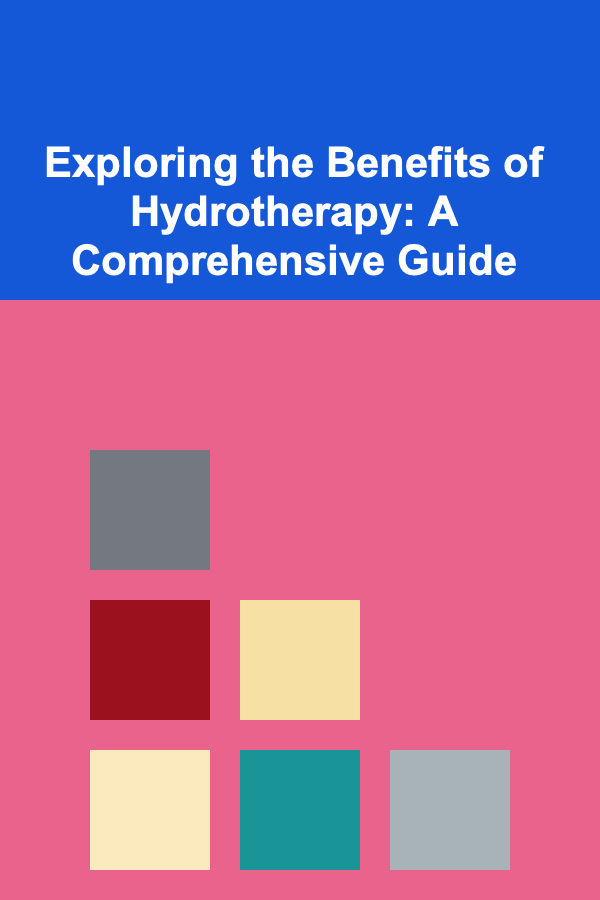
Exploring the Benefits of Hydrotherapy: A Comprehensive Guide
ebook include PDF & Audio bundle (Micro Guide)
$12.99$7.99
Limited Time Offer! Order within the next:

Hydrotherapy, also known as aquatic therapy or water therapy, encompasses a wide range of therapeutic techniques that utilize water for healing and rehabilitation. From ancient civilizations to modern medicine, the therapeutic properties of water have been recognized and harnessed to alleviate pain, improve function, and promote overall well-being. This comprehensive guide delves into the multifaceted benefits of hydrotherapy, exploring its history, mechanisms of action, various techniques, clinical applications, potential risks, and how to effectively incorporate it into a holistic health regimen.
A Brief History of Hydrotherapy
The use of water for medicinal purposes dates back millennia. Ancient Egyptians, Greeks, and Romans all understood and utilized the therapeutic properties of water. The Egyptians used bathing rituals for purification and healing, while the Greeks and Romans built elaborate bathhouses that served as centers for social interaction and medical treatment. Hippocrates, the father of medicine, advocated for the use of water to treat various ailments. The Romans, particularly, developed sophisticated plumbing systems and bathhouses, such as the famous Baths of Caracalla, which offered a variety of water-based treatments, including hot baths, cold plunges, and massage.
The practice of hydrotherapy continued throughout the Middle Ages and Renaissance, though its popularity fluctuated. In the 18th and 19th centuries, hydrotherapy experienced a revival in Europe and North America. Prominent figures like Vincent Priessnitz and Sebastian Kneipp championed the use of water cures, establishing hydrotherapy clinics and popularizing techniques like cold water immersion and herbal baths. These early pioneers laid the groundwork for the development of modern hydrotherapy practices.
Mechanisms of Action: How Hydrotherapy Works
The therapeutic effects of hydrotherapy are multifaceted and stem from several key properties of water:
Buoyancy
Buoyancy is the upward force exerted by a fluid that opposes the weight of an immersed object. In hydrotherapy, buoyancy reduces the stress on weight-bearing joints, making movement easier and less painful. This is particularly beneficial for individuals with arthritis, osteoarthritis, or injuries to the lower extremities. The reduced weight-bearing allows for increased range of motion, improved muscle strength, and enhanced balance and coordination.
Hydrostatic Pressure
Hydrostatic pressure is the pressure exerted by a fluid on an immersed object. This pressure increases with depth. In hydrotherapy, hydrostatic pressure helps to reduce swelling and edema by promoting venous return and lymphatic drainage. It also provides support and stability to joints, which can be particularly helpful for individuals with instability or hypermobility. Furthermore, hydrostatic pressure can improve circulation and reduce blood pressure.
Viscosity
Viscosity is the resistance of a fluid to flow. Water is more viscous than air, which means that movement in water requires more effort and provides resistance. This resistance can be used to strengthen muscles and improve endurance. The viscosity of water also provides a gentle form of resistance that is less jarring than traditional weight training, making it suitable for individuals recovering from injuries or those with limited strength.
Temperature
Water temperature plays a crucial role in hydrotherapy. Hot water can relax muscles, reduce pain, and improve circulation. It can also help to loosen stiff joints and increase flexibility. Cold water, on the other hand, can reduce inflammation, numb pain, and decrease muscle spasms. Alternating between hot and cold water can create a pumping action that further improves circulation and reduces swelling.
Psychological Effects
The warm embrace of water can have a profound psychological impact. Hydrotherapy can be incredibly relaxing and stress-reducing. The buoyancy and warmth of the water can create a sense of weightlessness and freedom, which can be particularly beneficial for individuals with anxiety, depression, or chronic pain. The rhythmic movements and soothing sounds of water can also promote relaxation and reduce tension.
Types of Hydrotherapy Techniques
Hydrotherapy encompasses a wide range of techniques, each designed to address specific conditions and therapeutic goals. Here are some of the most common and effective techniques:
Aquatic Exercise
Aquatic exercise involves performing exercises in a pool or other aquatic environment. These exercises can be tailored to individual needs and abilities, ranging from gentle stretching and range-of-motion exercises to more challenging cardiovascular and strengthening activities. Aquatic exercise is often used for rehabilitation after injuries, managing chronic pain, and improving overall fitness. The buoyancy of the water reduces stress on joints, making it an ideal form of exercise for individuals with arthritis or other musculoskeletal conditions.
Contrast Therapy
Contrast therapy involves alternating between hot and cold water immersion. This technique is often used to reduce inflammation, improve circulation, and relieve pain. Typically, individuals will immerse themselves in hot water for a few minutes, followed by a brief immersion in cold water. This cycle is repeated several times. Contrast therapy can be particularly effective for managing pain and swelling associated with sprains, strains, and other injuries.
Whirlpool Therapy
Whirlpool therapy involves immersing oneself in a tub of water with jets that create a swirling motion. The swirling water provides gentle massage, which can help to relax muscles, relieve pain, and improve circulation. Whirlpool therapy is often used to treat muscle spasms, joint stiffness, and other musculoskeletal conditions.
Hubbard Tank
A Hubbard tank is a large, butterfly-shaped tank designed for full-body immersion. It allows for a wide range of movements and exercises to be performed in the water. Hubbard tanks are often used for treating severe burns, spinal cord injuries, and other complex conditions that require extensive rehabilitation.
Pool Therapy
Pool therapy encompasses a variety of hydrotherapy techniques performed in a pool setting. This can include aquatic exercise, therapeutic swimming, and other water-based activities designed to improve function and well-being. Pool therapy is often used for individuals with neurological conditions, musculoskeletal disorders, and chronic pain.
Sauna and Steam Baths
While not strictly hydrotherapy in the sense of immersion, saunas and steam baths utilize heat and humidity for therapeutic purposes. Saunas use dry heat to induce sweating, which can help to detoxify the body and relax muscles. Steam baths use moist heat, which can help to clear congestion and improve respiratory function. Both saunas and steam baths can promote relaxation and reduce stress.
Water Massage
Water massage uses jets of water to massage the body. This can be done in a pool, tub, or specialized massage table. Water massage can help to relax muscles, relieve pain, and improve circulation. It is often used to treat muscle tension, back pain, and other musculoskeletal conditions.
Watsu
Watsu is a form of aquatic bodywork that involves gentle stretching, massage, and movement in warm water. The therapist supports and moves the client in the water, creating a sense of weightlessness and freedom. Watsu is often used to promote relaxation, reduce stress, and improve range of motion. It can be particularly beneficial for individuals with chronic pain, anxiety, or post-traumatic stress disorder (PTSD).
Swiss Shower
A Swiss shower involves multiple showerheads directed at the body from different angles. The water pressure and temperature can be adjusted to provide a stimulating and invigorating experience. Swiss showers are often used to improve circulation, reduce cellulite, and promote skin health.
Clinical Applications of Hydrotherapy
Hydrotherapy has a wide range of clinical applications and can be beneficial for individuals with various conditions. Here are some of the most common clinical applications of hydrotherapy:
Arthritis and Osteoarthritis
Hydrotherapy is highly effective for managing arthritis and osteoarthritis. The buoyancy of the water reduces stress on joints, making movement easier and less painful. The warm water can also help to relax muscles and reduce stiffness. Aquatic exercise, in particular, is a valuable tool for improving range of motion, muscle strength, and overall function in individuals with arthritis.
Back Pain
Hydrotherapy can provide significant relief for individuals with back pain. The buoyancy of the water reduces pressure on the spine, allowing for greater range of motion and reduced pain. Aquatic exercise can help to strengthen core muscles, which provide support for the spine. Warm water can also help to relax muscles and reduce muscle spasms.
Fibromyalgia
Hydrotherapy can be beneficial for managing fibromyalgia symptoms. The warm water can help to relax muscles, reduce pain, and improve sleep. Aquatic exercise can help to improve cardiovascular fitness, muscle strength, and overall function. The gentle movements in water are less likely to exacerbate pain than traditional exercises.
Neurological Conditions
Hydrotherapy can be used to treat a variety of neurological conditions, including stroke, multiple sclerosis (MS), and cerebral palsy. The buoyancy of the water provides support and reduces the risk of falls. Aquatic exercise can help to improve balance, coordination, and muscle strength. The warm water can also help to relax muscles and reduce spasticity.
Sports Injuries
Hydrotherapy is a valuable tool for rehabilitating sports injuries. The buoyancy of the water reduces stress on injured joints, allowing for earlier and less painful rehabilitation. Aquatic exercise can help to improve range of motion, muscle strength, and cardiovascular fitness. Contrast therapy can be used to reduce inflammation and promote healing.
Post-Surgical Rehabilitation
Hydrotherapy can be used to accelerate recovery after surgery. The buoyancy of the water reduces stress on surgical sites, allowing for earlier mobilization and reduced pain. Aquatic exercise can help to improve range of motion, muscle strength, and overall function. The warm water can also help to relax muscles and reduce swelling.
Burn Injuries
Hydrotherapy is an essential part of burn care. Hubbard tanks are often used to clean and debride burn wounds. The warm water can also help to reduce pain and promote healing. Aquatic exercise can help to improve range of motion, muscle strength, and overall function.
Mental Health
Hydrotherapy can have significant benefits for mental health. The warm water and buoyancy can promote relaxation, reduce stress, and improve mood. Aquatic exercise can release endorphins, which have mood-boosting effects. Watsu, in particular, can be a powerful tool for reducing anxiety, depression, and PTSD.
Respiratory Conditions
Steam inhalation and hydrotherapy techniques that utilize humidity can help to relieve symptoms of respiratory conditions like asthma, bronchitis, and sinusitis. The moist air can help to loosen congestion and make breathing easier.
Potential Risks and Precautions
While hydrotherapy is generally safe, there are some potential risks and precautions to be aware of:
Infections
Water can be a breeding ground for bacteria and other microorganisms. It is important to ensure that pools and tubs are properly cleaned and disinfected to prevent infections. Individuals with open wounds or infections should avoid hydrotherapy until the wounds have healed.
Drowning
Drowning is a serious risk, particularly for individuals who are not strong swimmers or have neurological conditions that affect balance and coordination. It is important to have supervision during hydrotherapy sessions, especially for vulnerable individuals.
Cardiovascular Issues
The warm water in hydrotherapy can increase heart rate and blood pressure. Individuals with cardiovascular conditions should consult with their doctor before starting hydrotherapy. It is important to monitor heart rate and blood pressure during hydrotherapy sessions and to avoid overexertion.
Skin Irritation
Some individuals may experience skin irritation from the chemicals used to disinfect pools and tubs. It is important to rinse off thoroughly after hydrotherapy sessions and to moisturize the skin. Individuals with sensitive skin may need to take extra precautions to avoid irritation.
Dehydration
Sweating in warm water can lead to dehydration. It is important to drink plenty of water before, during, and after hydrotherapy sessions.
Contraindications
There are certain conditions that may make hydrotherapy unsafe. These include:
- Fever
- Uncontrolled high blood pressure
- Severe kidney disease
- Severe heart failure
- Infectious diseases
- Uncontrolled seizures
- Open wounds or infections
It is important to consult with a doctor or physical therapist before starting hydrotherapy to ensure that it is safe and appropriate for your individual needs.
Incorporating Hydrotherapy into Your Health Regimen
If you are interested in exploring the benefits of hydrotherapy, here are some tips for incorporating it into your health regimen:
Consult with a Healthcare Professional
The first step is to consult with your doctor or a physical therapist. They can help you determine if hydrotherapy is appropriate for your condition and can provide guidance on the best techniques to use.
Find a Qualified Therapist or Facility
Look for a qualified hydrotherapist or a facility with experienced staff and well-maintained equipment. Make sure the facility follows proper sanitation protocols to minimize the risk of infection.
Start Slowly
If you are new to hydrotherapy, start slowly and gradually increase the duration and intensity of your sessions. Pay attention to your body and stop if you experience any pain or discomfort.
Stay Hydrated
Drink plenty of water before, during, and after hydrotherapy sessions to prevent dehydration.
Listen to Your Body
Pay attention to your body and stop if you experience any pain, dizziness, or other discomfort. Hydrotherapy should be a relaxing and enjoyable experience.
Combine with Other Therapies
Hydrotherapy can be combined with other therapies, such as physical therapy, massage therapy, and acupuncture, to enhance its benefits.
Make it a Regular Practice
To experience the full benefits of hydrotherapy, make it a regular practice. Aim for at least two to three sessions per week.
Conclusion
Hydrotherapy offers a wealth of benefits for physical and mental well-being. From its ancient origins to its modern applications, the therapeutic properties of water have been consistently recognized and utilized to alleviate pain, improve function, and promote overall health. By understanding the mechanisms of action, exploring various techniques, and taking necessary precautions, you can effectively incorporate hydrotherapy into your health regimen and experience its transformative potential. Whether you are seeking relief from chronic pain, recovering from an injury, or simply looking for a relaxing and rejuvenating experience, hydrotherapy offers a safe and effective path to enhanced health and well-being. Remember to consult with a healthcare professional to determine the best approach for your individual needs and enjoy the many benefits that hydrotherapy has to offer.

How to Create a Morning Routine That Maximizes Organization
Read More
How to Find Budget-Friendly Storage Solutions for Your Hobby Room
Read More
How to Keep Up with Market Trends in Rental Properties
Read More
How to Plan a Family Movie Marathon on a Budget
Read More
How to Overcome Procrastination in a Remote Setting
Read More
How to Make Your Home Energy Independent
Read MoreOther Products

How to Create a Morning Routine That Maximizes Organization
Read More
How to Find Budget-Friendly Storage Solutions for Your Hobby Room
Read More
How to Keep Up with Market Trends in Rental Properties
Read More
How to Plan a Family Movie Marathon on a Budget
Read More
How to Overcome Procrastination in a Remote Setting
Read More